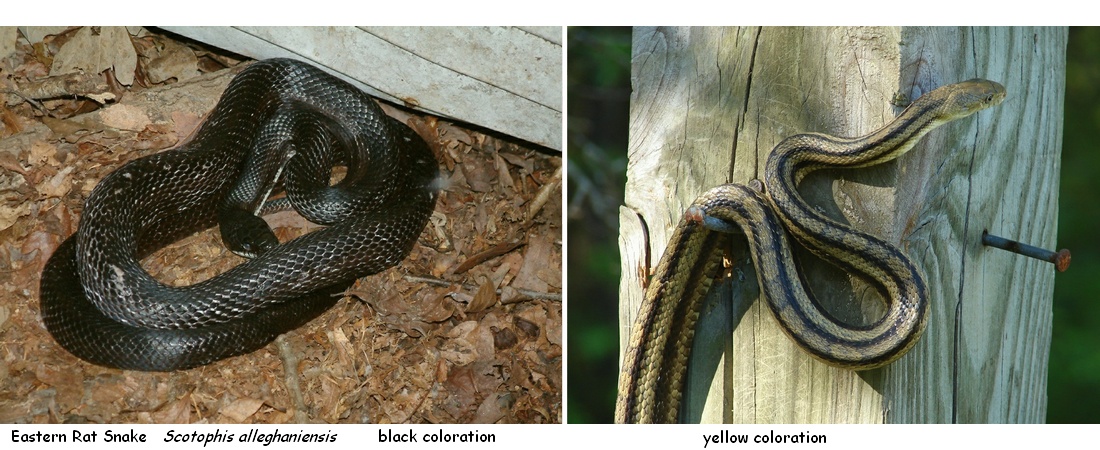
|
Family: Colubridae - Harmless Egg-Laying Snakes Typical Adult Size: 42 to 72 inches Reproduction: egg laying Eye Pupil: round Dorsal Scales: weakly keeled Anal Scale: divided |
Eastern Rat Snakes are large constricting snakes which are found throughout South Carolina and most of the eastern United States. They are weekly keeled to smooth scaled. Specimens longer than six feet are not rare.
For most of its range, adult Eastern Rat Snakes appear shiny black. However, in bright light a faint blotched pattern may be seen. Their chins and throats are white, changing to checkerboard black and white and then to cloudy gray on the belly. Young Black Rat Snakes are strongly blotched against a gray background and could be easily mistaken for a different species. Such black specimens formerly known as Black Rat Snakes and given a subspecies name of obsoleta
In most of pennisula Florida, the adult Eastern Rat Snake is very differently patterned and colored. They have a yellow dorsal background color with four dark stripes running the length of the body. Such specimens were formerly known as Yellow Rat Snakes and given a subspecies name of quadrivittata. Specimens of this coloration have plain cream/yellow bellies and lack the white coloration under the chin and throat.
In the Carolinas and Georgia, the yellow coloration of the Eastern Rat Snake is dominant along the coastal counties. In areas of these states above the coastal plain, the black coloration dominates. In the upper coastal plain, the black yellow colorations are mixed, yielding adult specimens with blotches, blotches and stripes, and in some cases, a greenish background color.
Eastern Rat Snakes are not venomous, but may bite if handled carelessly. Ratsnakes are relatively slow moving and will most often freeze when first encountering danger. This is why so many are killed on our roadways. When freezing while crawling on the ground they will often take on a rippled posture, looking like a large unironed ribbon.
Although most specimens are discovered on the ground, Rat Snakes are good climbers. I once observed a specimen raiding a gray squirrel nest high in a tree in November after most leaves had fallen. Rodents, birds and bird eggs, and lizards are favored prey by rat snakes. Rat snakes do ocassionally raid hen houses, eating chicks or eggs. For this reason, they are sometimes called "Chicken Snakes."
Based upon the e-mail inquiries I receive, neonate Black Rats are the most frequently found snakes entering homes, usually in the early Fall or Spring. Adults will also enter homes. For more information about Rat Snakes entering homes, visit my FAQ page.
Return to SC Snake Index
July 07, 2009
Contact: South Carolina Reptiles and Amphibians
Notes: 1
The scientific and common names for North American Rat Snakes have undergone major changes
during the last few years. Rat Snakes, Corn Snakes, and Fox Snakes (not found in South Carolina)
were previously placed in the genus Elaphe. This was the same genus used for European Rat Snakes.
In recognition of the evolutionary distinction between New World and Old World Rat Snakes, the genus
Pantherophis was proposed for the New World Rat Snakes. However, further studies revealed problems
with separating the Rat Snakes from the Bull Snakes, genus Pituophis. To solve this difficulty,
the former genus Elaphe was replaced by three new genuses: Scotophis for the former
Elaphe obsoleta species (Rat Snakes); Pantherophis for the former Elaphe guttata species
(Corn Snakes); and Mintonius for the former Elaphe vulpina species (Fox Snakes).
These name changes have recently been incorporated to this website. Therefore, many prior images and references
will still contain the older names with the genus Elaphe. Updates will be implemented gradually.
Return to top of page